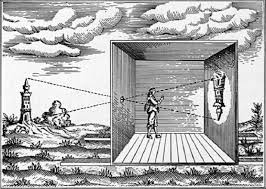Photography is one of the most influential visual arts of the modern era. The development of photography can be traced back to the early photography was invented by Frenchman Nicéphore Niépce in 1822. Niépce developed a technique called heliography, which he used to create the world’s oldest surviving photograph, View from the Window at Le Gras.

The Camera Obscura
The term “camera obscura,” meaning “dark room” in Latin means to an optical device used to project an image of its surroundings onto a screen. The basic concept involves light passing through a small hole into a darkened room or box, forming an inverted image of the outside scene on the opposite wall which would turn upside down, artists such as Leonardo da Vinci used the camera obscura to study photography but camera obscura couldn’t fix or capture the image.

Frenchman, Louis Daguerre- daguerreotype
In 1839, Frenchman, Louis Daguerre introduced the daguerreotype, the first widely used photographic process.
The daguerreotype process involved exposing a silver-coated copper plate to iodine vapor, which made the plate sensitive to light. After exposure, the plate was developed using mercury vapor and fixed with a solution of salt, creating a detailed and permanent image. One of the major advantages of the daguerreotype was its relatively short exposure time—ranging from a few minutes to half an hour, a significant improvement over Niépce’s heliographs.
The daguerreotype became worldwide, especially in portraiture. For the first time, people could obtain a true likeness of themselves or loved ones He created the first image that could be fixed.

The Calotype
In the same year Daguerre announced his invention, British scientist William Henry Fox Talbot introduced the calotype. the calotype was based on the concept of the negative-positive process, which allowed for multiple prints to be made from a single negative.
Talbot’s method involved exposing paper coated with silver iodide to light, producing a negative image. This negative could then be used to create positive prints by placing it against another sheet of sensitized paper and exposing it to light.

Collodion
The invention of the collodion, This process involved coating a glass plate with a solution of collodion, a sticky substance, and then sensitizing it with silver nitrate. This process produced highly detailed images.
In 1888, the introduction of the Kodak camera by George Eastman marked another turning point in the history of photography. He made photography accessible to the general public by making The Kodak camera. although it was small it was portable, and used roll film in the 20th century
Romanticism
Not forgetting, Romanticism. It’s all about emotion, individualism, and a deep connection to nature. Romanticism is often associated with painting, literature, and music, it has significantly influenced photography, looking at the themes of nature, emotion, and the sublime, and how photographers use visual techniques to capture these ideas and make each photo unique and beautiful in its own way.
Conclusion
The origins of photography are centuries of scientific and technological research. Niépce, Daguerre, and Talbot each proved the idea of realization and the ability to capture and preserve moments in time, as technology advanced, photography evolved, it also shapes how we see the world.
Conclusion
Photography started out as a cool science experiment, but it quickly became something way deeper. It can turn the everyday into something extraordinary, like how Andrew Krater captured Paris in 1928—his photos made him fall in love with the city so much that he had to go back for more.
What’s awesome about photography is that it shows how things look while also changing how we see them. The camera might be objective, but the person behind it—like me—adds their own vibe and perspective.
At its core, photography is all about framing an image and figuring out how light, angles, and shapes come together. The camera obscura is a classic example: it’s basically a simple black box that uses darkness to let in light, creating upside-down images. Even though this idea has been around for ages, it wasn’t until the 19th century that people figured out how to actually capture those images and keep them.
In 1839, Louis Daguerre and Henry Fox Talbot get a lot of credit for “starting photography,” but it’s important to remember that the camera obscura existed long before them. Daguerre came up with the daguerreotype in the 1840s, the first method that people could actually use to take pictures, while Talbot’s calotype, introduced in 1841, used paper coated with silver iodide to create softer images.
Both processes reflect the romantic vibe of that time, focusing on personal experiences and how we view the world. As I dive into photography myself, I’m super excited to explore this rich history and find my own unique voice in the art.
